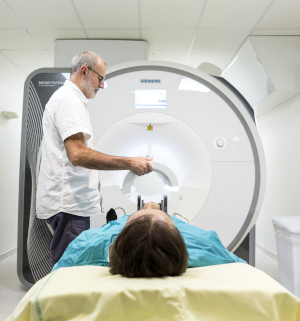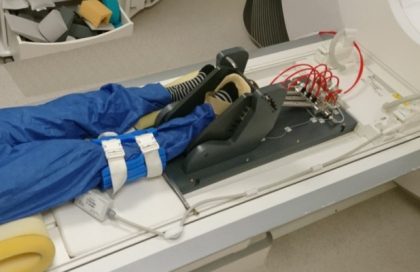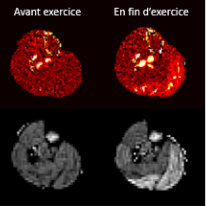
Interview with Alfredo Lopez Kolkovsky, researcher from the NMR Imaging and Spectroscopy Laboratory at the Neuromuscular Investigation Centre of the Institute of Myology, jointly managed by H. Reyngoudt and B. Marty. He is the first author of an article* published in the journal Magnetic Resonance in Medicine on the assessment of energy metabolism and blood flow by NMR during and after exercise targeting the calf.
What is the general context of the project?
Nuclear magnetic resonance (NMR) is a non-invasive and quantitative method for assessing pathological or ageing skeletal muscle. This technique is particularly suited to testing the efficacy of innovative therapeutic strategies, whether gene therapy or pharmacological interventions, or simply physical rehabilitation or the use of food supplements.
In addition to certain quantitative indicators relating to muscle anatomy or muscle tissue structure, NMR is also used to assess several aspects of the physiological response to a functional test: energy use, the effectiveness of mitochondria in re-producing the energy used, but also vascular response and blood flow in the engaged muscles. These unique assessments allow very detailed analysis of certain physiological and biochemical mechanisms that contribute directly to physical performance and provide key, complementary information to conventional functional assessments.

Our NMR Laboratory at the Institute of Myology is pioneering the development of multiparametric functional assessments, allowing these variables to be measured simultaneously every two seconds. The instrumentation required for these multiparametric measurements was previously only available in NMR machines reserved for research, preventing use in a clinical context in ‘conventional’ MRI. Our development has allowed us to overcome these restrictions in new-generation MRI. Ergometers compatible with high magnetic fields have also been developed, allowing us to perform a calf exercise suited to each subject inside the MRI during the acquisition of multiparametric measurements.
This multiparametric functional strategy, currently applied to the calf, is particularly suited to the study of metabolic and inflammatory disorders, and also sheds light on the aetiology for excessive loss of strength observed in sarcopenia and the possible decline in ageing muscle ‘quality’.
What are the objectives?
This study aims to validate a protocol with multiparametric functional measurements for routine clinical application, and to assess its reproducibility for use in clinical trials. The detailed description of the method also aimed to make it accessible to the scientific community, and establish our position as a reference site.
Which methods and protocols were used?
Firstly, individual modules were developed to measure energy aspects, vascular changes, blood flow in tissue, together with intracellular oxygen desaturation. These methods were validated individually and then combined to enable multiparametric measurement.
 At the same time, two MRI-compatible ergometers were developed to perform plantar flexion or extension, the first specifically designed for adults without any major muscular impairment and the second reserved for children and physically weak subjects.
At the same time, two MRI-compatible ergometers were developed to perform plantar flexion or extension, the first specifically designed for adults without any major muscular impairment and the second reserved for children and physically weak subjects.
A prototype probe or ‘sensor’ was developed jointly with a specialist external manufacturer to achieve high-precision measurements in the calf.
The precision and reproducibility of this investigational device were then tested on healthy volunteers, using a plantar flexion paradigm, before use in patients (metabolic myopathy).
MRI-compatible ergometer
for calf exercises

What results were obtained?
The biochemistry values together with the reproducibility of our multiparametric measurements are fully consistent with the values observed by other teams using conventional methods in which only a single variable is measured in the paradigm.
These simultaneous measurements have enhanced the value of the examinations since multiple datasets are generated at the same time for a given subject, which is a key advantage in studying complex phenomena, such as oxidative energy production involving multiple interactive mechanisms.
In this study, for instance, substantial acidification of the muscle was observed to be associated with a stronger vascular response and higher tissue blood exchange.
Capillary blood exchange (top)
and vascular response (bottom)
What conclusions can be drawn and what are the potential prospects?
This study served to demonstrate that our multiparametric method does not introduce any bias in the results or their reproducibility relative to a conventional NMR approach measuring a limited number of values per examination. In addition to reducing the overall duration of the examination, this approach improves the interpretation of muscle physiological response during physical exertion.
This achievement represents a milestone, after several years of technical developments undertaken with the objective of allowing these multiparametric measurements to become more readily accessible to patients in standard clinical 3T MRI. These instruments will be included in several clinical protocols with the objective of studying muscle ageing and sarcopenia in adults, with recruitment of volunteers of all ages currently in progress. A variant of the current multiparametric method is currently in development for application to the thigh and, more specifically, to the quadriceps, an early target in the ageing process.
